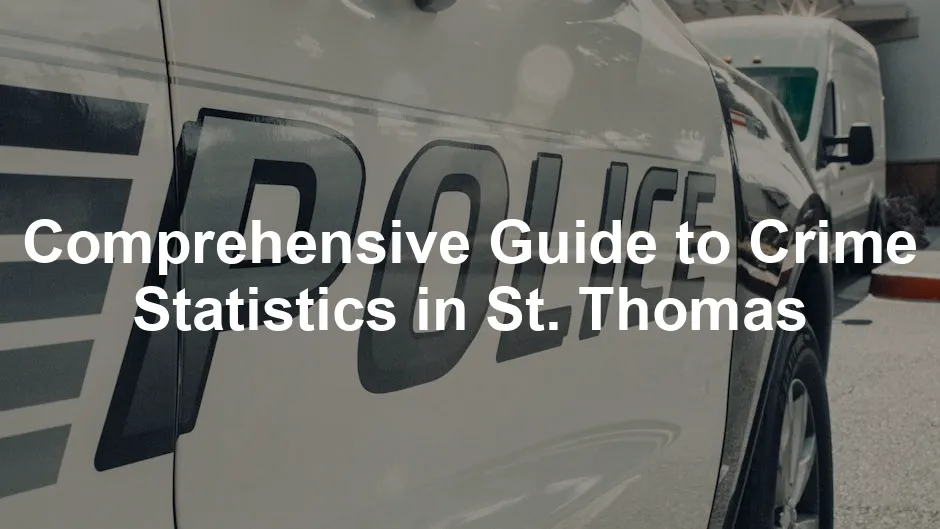Introduction
Crime statistics in St. Thomas are more than just numbers. They reveal the pulse of the community, offering insights that affect both residents and tourists alike. Understanding these trends is crucial for anyone considering a visit or a move to this picturesque island. Knowledge is power, and when it comes to safety, it’s better to be informed than oblivious.
Data sources for crime statistics include local police reports, community surveys, and platforms like Numbeo. These resources help paint a clearer picture of crime trends. They provide valuable insights that guide decision-making regarding safety and living conditions. For example, knowing the crime rate can help you choose the safest neighborhoods or inform tourists about areas to avoid after dark.
In this article, we will cover various aspects of crime statistics in St. Thomas. You can expect comparisons between different locations within St. Thomas, such as the US Virgin Islands and Canada. We will also discuss how these statistics impact community safety, helping you understand the broader implications of crime data on everyday life. So, buckle up! It’s time to unpack the numbers and see what they mean for you.

Understanding Crime Statistics
What Are Crime Statistics?
Crime statistics are a collection of data that reflect the frequency and types of crimes reported in a specific area. They serve a critical purpose in public safety by helping authorities assess crime trends over time. These statistics can influence local policies, law enforcement strategies, and community programs aimed at reducing crime.
For residents, understanding these numbers can lead to better safety practices and community awareness. For tourists, crime statistics can affect travel plans and perceptions of safety. Ultimately, crime statistics provide a factual basis for assessing risk and making informed decisions about safety in St. Thomas. Whether it’s identifying safe neighborhoods or understanding the likelihood of certain crimes, these figures are essential for everyone involved.
Speaking of safety, consider investing in a Home Security System to protect your home. With increasing concerns about property crime, having a reliable security system can provide peace of mind and deter potential intruders.

How Crime Data is Collected
Crime data collection is vital for understanding the safety landscape in St. Thomas. This data comes from various sources, including police reports, surveys, and community feedback.
Police departments compile reports on incidents, arrests, and response times. These records provide a foundational understanding of crime trends. Surveys also play a significant role. They capture residents’ perceptions of safety and their experiences with crime. Community feedback further enriches this data, revealing local concerns and specific issues faced by residents.
If you’re looking to enhance your personal safety, consider a Personal Safety Alarm. It’s a small device that can make a big difference, alerting others if you find yourself in a precarious situation.

Crime Index and Safety Index
When navigating the crime landscape in St. Thomas, two key metrics come into play: the Crime Index and the Safety Index. According to Numbeo, St. Thomas has a Crime Index of 64.16 and a Safety Index of 35.84.
But what do these numbers mean? The Crime Index measures the overall crime level in an area, with higher values indicating more crime. For St. Thomas, a score of 64.16 suggests a significant presence of crime, which might raise eyebrows among residents and potential visitors.
On the flip side, the Safety Index gauges how safe people feel in their surroundings. A score of 35.84 indicates that many residents harbor concerns about safety, particularly when walking alone at night.
Digging deeper, the data reveals troubling trends. For instance, 77.94% of respondents perceive a high level of crime, and 75% believe crime has increased in the past five years. Worries about home invasions (61.11%), being mugged (62.5%), and general safety (61.11%) are prevalent.
In essence, the Crime and Safety Indexes serve as essential tools for understanding and addressing the crime situation in St. Thomas. They empower residents with knowledge, helping them make informed decisions about their safety and community engagement.

Property Crime
In St. Thomas, property crime remains a pressing concern. The property crime rate stands at 35.57 per 1,000 residents, which is quite alarming. This figure reflects various offenses, including burglary, theft, and vandalism.
Burglary, the unauthorized entry into a building with the intent to commit a crime, has seen significant occurrences. Many residents express fear of home invasions. It’s not just a number; it’s a real worry for families and homeowners. Theft, especially car theft, has also contributed to the anxiety among locals. The prevalence of items being stolen from vehicles adds another layer of concern.
Additionally, vandalism paints a grim picture. It’s not just about broken windows or graffiti; it’s about community pride. When neighborhoods suffer from vandalism, it diminishes the sense of safety and belonging. The anxiety around property crimes has led many to take extra precautions, such as installing Outdoor Security Cameras or joining neighborhood watch programs.
Local law enforcement is aware of these issues and is working tirelessly to mitigate them. Community engagement initiatives have popped up, encouraging residents to report suspicious activities. This collaborative approach is essential. After all, a community that looks out for one another can significantly reduce crime rates.
The statistics not only represent numbers but depict a community grappling with safety concerns. Each theft, burglary, or act of vandalism tells a story. It’s crucial for residents and visitors alike to stay informed and vigilant. The more aware everyone is, the safer St. Thomas can become.

Drug-Related Crime
Drug-related crimes in St. Thomas are a significant issue, intertwining with various other criminal activities. The problem isn’t just about illegal substances but extends to the crimes committed to support drug habits. These offenses often lead to an uptick in thefts and assaults, as individuals may resort to desperate measures for funds.
The correlation between drug-related crimes and property crimes is particularly concerning. For instance, many thefts can be traced back to individuals looking to fund their drug use. This vicious cycle creates an atmosphere of fear and insecurity within the community. Residents often express worries about the influence of drugs on local safety, with many believing that it exacerbates other crime rates.
Moreover, the perception of drug-related issues affects tourism. Visitors might hesitate to explore certain areas, fearing they could encounter dangerous situations. This is detrimental to the local economy, which relies heavily on tourism.
Efforts to address drug-related crimes are underway. Local law enforcement is focusing on community outreach programs that aim to educate residents about the dangers of drugs and the importance of reporting suspicious activities. As awareness grows, communities can work together to combat these pressing issues.

Comparisons with Other Regions
St. Thomas, US Virgin Islands vs. St. Thomas, Canada
When comparing crime statistics, St. Thomas in the US Virgin Islands and St. Thomas in Canada reveal stark contrasts. In the US Virgin Islands, the crime index is notably high at 64.16, indicating significant safety concerns. The property crime rate is a staggering 35.57 per 1,000 residents, while the violent crime rate stands at 9.78 per 1,000 residents.
In contrast, St. Thomas, Canada, boasts a lower crime index of 58.92. Although still concerning, the overall crime levels are more manageable. The property crime rate here is lower than its Virgin Islands counterpart, standing at 3,345 incidents per 100,000 people.
This disparity highlights the different challenges faced by these regions. The US Virgin Islands grapples with more severe crime rates, which affect both residents and tourists. In contrast, while Canada’s St. Thomas experiences crime, it operates under a different set of circumstances.
The factors influencing these crime rates are varied. Economic conditions, community engagement, and law enforcement resources all play a role. For example, the US Virgin Islands faces higher unemployment rates and social issues, contributing to its higher crime statistics.
Understanding these differences is essential for both residents and visitors. Awareness can foster informed decision-making regarding safety and community initiatives.

Historical Comparisons
Examining historical crime rates in St. Thomas reveals a troubling trend. Over the past decade, crime rates have consistently increased, causing growing concern among residents and local authorities alike.
In the early 2010s, the crime rate was significantly lower, with fewer reported incidents of both property and violent crimes. However, as the population has grown and economic challenges have intensified, the rates have surged. For instance, the property crime rate has escalated from approximately 25 per 1,000 residents to the current 35.57 per 1,000 residents.
The increase in drug-related crime has also contributed to this upward trend. Authorities report a direct correlation between drug abuse and rising theft rates. As more individuals struggle with addiction, the community faces greater risks.
Local law enforcement has responded with various initiatives aimed at curbing these rising rates. Community policing efforts and crime prevention programs have been introduced to engage residents and promote safety. Involving the community is vital for addressing the root causes of crime.
Reflecting on these historical changes underscores the importance of ongoing vigilance. Understanding the past helps inform future strategies for improving safety in St. Thomas. Community involvement and awareness are essential components in the fight against crime.

Community Impact
Effects on Residents
Rising crime rates in St. Thomas have a profound impact on the daily lives of its residents. When crime is on the rise, the sense of security plummets. Residents often find themselves looking over their shoulders while walking down the street, worrying about becoming a statistic. This constant state of alertness can be exhausting.
Home invasions are a particular concern. Over 61% of residents express fear of their homes being broken into. This anxiety leads many to invest in security systems, neighborhood watch programs, and other safety measures. It’s not just about protecting belongings; it’s about peace of mind. Families become hesitant to let their kids play outside, fearing for their safety.
Moreover, businesses feel the pinch. Local shops may experience decreased foot traffic as potential customers avoid areas perceived as dangerous. This can lead to economic downturns, leading to even more crime as opportunities dwindle. The lack of a thriving local economy only exacerbates community tensions, creating a vicious cycle of fear and isolation.
Residents also report increased stress and anxiety levels. With crime rates soaring, mental health can suffer. Communities may become fragmented as people retreat into their homes, fostering a culture of mistrust. Everyone becomes a potential suspect, and friendships can fray under the weight of suspicion.
In short, rising crime rates don’t just impact statistics; they affect the very fabric of community life. When safety is compromised, daily routines are disrupted, and the vibrant life of St. Thomas dims.

Tourist Safety Concerns
Tourist perceptions of St. Thomas are greatly influenced by crime statistics. When headlines scream about rising crime, potential visitors think twice before booking that dream vacation.
Imagine planning a trip to a beautiful island, only to discover that 77.94% of locals believe crime is high. Tourists want to feel safe while exploring the picturesque beaches and vibrant markets. Unfortunately, many fear becoming victims of theft or violent crime. The worry about being mugged or having belongings stolen can deter even the most adventurous traveler.
Moreover, crime statistics can skew tourists’ experiences. While St. Thomas has stunning attractions, concerns about safety may lead visitors to avoid certain areas or activities. This can affect local businesses that rely on tourism. When tourists shy away from popular spots, the local economy takes a hit, resulting in a loss of jobs and opportunities for residents.
Local tourism boards must work hard to reassure potential visitors. They need to highlight safety initiatives and community efforts to combat crime. Showing that the community cares about safety can help rebuild trust with tourists.
Ultimately, crime statistics have far-reaching implications for tourism in St. Thomas. A decline in visitors can lead to economic strain, affecting everyone from hotel staff to local artisans. It’s a delicate balance between ensuring safety and promoting the island’s beauty.

Response from Law Enforcement
Local law enforcement in St. Thomas is stepping up to tackle rising crime rates. The police are aware that safety concerns dominate community discussions. Therefore, they are implementing strategies to address these issues head-on.
Increased patrols in high-crime areas are just one approach. Officers aim to create a visible presence, letting residents know they are not alone in their fight against crime. Community engagement is also a key focus. Building relationships with residents fosters trust and encourages them to report suspicious activities. This partnership can lead to faster responses and deter criminal behavior.
Additionally, law enforcement is leveraging technology. Crime mapping tools help identify hotspots, allowing police to deploy resources more effectively. Social media campaigns inform the community about safety tips and ongoing initiatives. Keeping the public informed not only empowers residents but also promotes a sense of shared responsibility for safety.
Moreover, addressing underlying social issues plays a crucial role. Police are collaborating with local organizations to provide resources for mental health and addiction issues. By tackling the root causes of crime, they aim to create a safer environment for everyone in St. Thomas.
In summary, law enforcement’s response to the rising crime trend is multifaceted. Through increased patrols, community engagement, and addressing social issues, the police are committed to restoring safety and confidence in St. Thomas. The path ahead is challenging, but a united community can make a significant difference.

Safety Measures and Crime Prevention
Community Initiatives
Community initiatives play a vital role in reducing crime in St. Thomas. Local organizations, residents, and law enforcement are coming together to create a safer environment.
Neighborhood watch programs have gained traction, empowering residents to keep an eye on each other’s properties. When neighbors look out for one another, the sense of community strengthens. These programs foster trust, encouraging open communication about safety concerns.
Local events focused on crime prevention also help raise awareness. Workshops on personal safety, self-defense classes, and informational sessions about local crime trends can develop a more vigilant community. Engaging residents in discussions about crime fosters a proactive mindset.
Speaking of personal safety, carrying a Self-Defense Keychain can be a great way to feel more secure while out and about. It’s discreet yet effective in ensuring you have a means to defend yourself if needed.
Partnerships with schools are also crucial. Educational programs on safety and awareness equip students with the knowledge they need to stay safe. When children learn about crime prevention early on, they carry that knowledge into adulthood, creating a more informed community overall.
Additionally, social media campaigns help spread the word about crime prevention efforts. By utilizing platforms like Facebook and Instagram, local organizations can reach a broader audience, inspiring more residents to get involved.
These community initiatives not only aim to reduce crime but also strengthen the bonds among residents. When everyone works together, the community becomes resilient against criminal activities, creating a safer St. Thomas for all.

Personal Safety Tips
Staying safe in St. Thomas is essential for both residents and tourists. Here are some practical tips to help ensure personal safety.
First, always be aware of your surroundings. Whether walking, shopping, or dining, staying alert can help you spot potential dangers. Avoid distractions, such as excessive phone use, that can make you an easy target.
Second, avoid displaying valuable items like jewelry or electronics in public. Keeping your belongings out of sight can deter thieves. When parking, always lock your vehicle and avoid leaving valuables inside, even if they’re hidden.
Third, familiarize yourself with the area. Knowing which neighborhoods are safe and which to avoid can make a big difference. Tourists should consult local guides or ask locals for advice on safe spots to explore.
Fourth, travel in groups when possible. There’s safety in numbers. Whether you’re a resident or a tourist, exploring with friends or family can reduce risks significantly.
Lastly, trust your instincts. If a situation feels off, don’t hesitate to leave. Your safety should always come first.
By following these personal safety tips, both residents and tourists can contribute to a safer St. Thomas. Awareness and preparedness go a long way in creating a secure community.

FAQs
What is the current crime rate in St. Thomas?
As of the latest data, St. Thomas has a Crime Index of 64.16, indicating a high level of crime. The overall crime rate stands at approximately 45 per 1,000 residents, with a violent crime rate of 9.78 per 1,000 residents. These figures highlight significant safety concerns for both residents and tourists.
How does St. Thomas compare to other cities in terms of crime?
St. Thomas has a higher crime rate than many other cities in the U.S. In fact, it ranks above 97% of U.S. cities when it comes to overall crime. While some cities may experience lower rates of property crime or violent crime, St. Thomas’s statistics reveal a pressing need for community safety initiatives and law enforcement support.
What resources are available for residents concerned about crime?
Residents of St. Thomas can access various resources aimed at crime prevention and safety. Local law enforcement agencies provide hotlines for reporting suspicious activities. Community organizations often host workshops and seminars on personal safety. Additionally, neighborhood watch programs encourage residents to collaborate in monitoring their surroundings.
How can tourists stay safe while visiting St. Thomas?
Tourists should take certain precautions to enhance their safety while visiting St. Thomas. Firstly, it’s wise to avoid displaying valuables and to stay aware of your surroundings at all times. Traveling in groups can also provide added security. Familiarize yourself with local areas, and don’t hesitate to ask locals for advice on which neighborhoods are safe. Lastly, always trust your instincts; if something feels off, it’s better to err on the side of caution.
Please let us know what you think about our content by leaving a comment down below!
Thank you for reading till here 🙂
For a deeper understanding of the current safety situation, check out the Fremont Crime Statistics.
All images from Pexels




